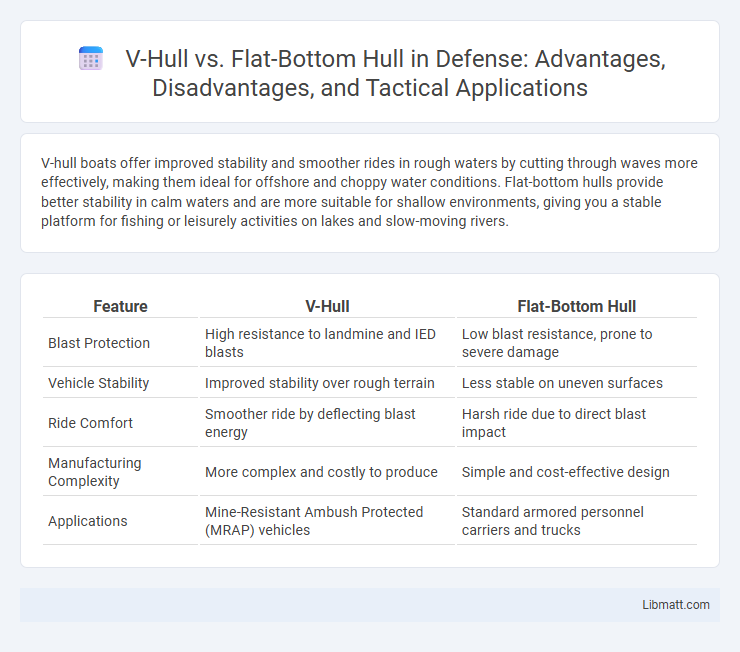V-hull boats offer improved stability and smoother rides in rough waters by cutting through waves more effectively, making them ideal for offshore and choppy water conditions. Flat-bottom hulls provide better stability in calm waters and are more suitable for shallow environments, giving you a stable platform for fishing or leisurely activities on lakes and slow-moving rivers.
Table of Comparison
| Feature | V-Hull | Flat-Bottom Hull |
|---|---|---|
| Blast Protection | High resistance to landmine and IED blasts | Low blast resistance, prone to severe damage |
| Vehicle Stability | Improved stability over rough terrain | Less stable on uneven surfaces |
| Ride Comfort | Smoother ride by deflecting blast energy | Harsh ride due to direct blast impact |
| Manufacturing Complexity | More complex and costly to produce | Simple and cost-effective design |
| Applications | Mine-Resistant Ambush Protected (MRAP) vehicles | Standard armored personnel carriers and trucks |
Introduction to Hull Types: V-Hull vs Flat-Bottom
V-hull designs feature a sharp, angled keel that slices through water, enhancing stability and handling in rough conditions, ideal for offshore and high-speed boating. Flat-bottom hulls offer superior stability on calm waters and easy planing, making them suitable for fishing, leisure boating, and shallow water navigation. Choosing between V-hull and flat-bottom hulls depends on intended water conditions, required stability, and performance preferences.
Key Differences Between V-Hull and Flat-Bottom Hull
V-hull boats feature a deep, V-shaped design that enhances stability and smoothness in choppy waters, making them ideal for offshore and rough conditions. Flat-bottom hulls provide superior stability in calm, shallow waters, offering better maneuverability and easier beaching, but they tend to pound and have less comfort in waves. The key differences lie in their hydrodynamic performance, with V-hulls excelling in wave cutting and speed, while flat-bottom hulls prioritize stability and shallow draft.
Stability and Performance on Water
V-hull designs enhance stability and performance by cutting through waves more efficiently, offering smoother rides in rough waters and better handling at higher speeds. Flat-bottom hulls provide superior initial stability, making them ideal for calm waters and activities like fishing or slow cruising, but they tend to pound and lose stability in choppy conditions. The choice between V-hull and flat-bottom hull depends on the intended use, with V-hulls favored for speed and rough water performance, while flat-bottom hulls excel in shallow, calm environments.
Handling in Rough vs Calm Waters
V-hull boats excel in rough waters due to their sharp angled design that cuts through waves, providing a smoother ride and better directional stability. Flat-bottom hulls perform best in calm waters, offering superior stability and a shallow draft but tend to pound and become less comfortable in choppy conditions. Choosing between these hull types depends heavily on the typical water conditions faced and the desired balance between speed, comfort, and stability.
Speed and Fuel Efficiency Comparison
V-hull designs offer superior speed and fuel efficiency by reducing water resistance and providing a smoother ride in choppy conditions. Flat-bottom hulls create more drag due to their larger surface area in contact with the water, resulting in slower speeds and increased fuel consumption. Choosing a V-hull can enhance your boat's performance and optimize fuel usage on longer trips.
Suitability for Fishing and Water Sports
V-hull boats offer superior stability and smoother rides in choppy waters, making them ideal for fishing trips in lakes and coastal areas where waves are common. Flat-bottom hulls provide excellent stability in calm waters, perfect for freshwater fishing and recreational water sports like tubing or wakeboarding in lakes or slow rivers. Your choice depends on where you plan to fish or play, as V-hulls handle rough conditions better while flat-bottom boats excel in calm, shallow environments.
Shallow Water Navigation Capabilities
V-hull boats offer enhanced stability and improved performance in shallow water by cutting through waves with less resistance, reducing the risk of grounding. Flat-bottom hulls provide excellent shallow water navigation due to their wide, stable base and minimal draft, allowing them to glide over shallow areas with ease. Both hull types are favored for different shallow water applications, with flat-bottom hulls excelling in calm, shallow environments and V-hulls better suited for rougher shallow water conditions.
Maintenance and Durability Factors
V-hull boats typically require more maintenance due to their complex shape, which can accumulate debris and suffer from hull chipping in rough waters, whereas flat-bottom hulls offer easier cleaning and fewer hidden crevices. The durability of V-hull boats excels in handling rough seas and heavy impacts, resulting in longer-lasting structural integrity under turbulent conditions. Your choice depends on whether you prioritize easier upkeep with moderate durability or enhanced stability with potentially higher maintenance needs.
Cost Considerations and Ownership
Flat-bottom hull boats often have lower initial costs due to simpler construction and materials, making them an affordable choice for budget-conscious buyers. V-hull boats, while generally more expensive upfront, offer enhanced stability and smoother rides in rough waters, which can reduce maintenance costs related to wear and tear over time. Your ownership experience will vary based on usage; flat-bottom hulls are ideal for calm, shallow waters and easy transport, whereas V-hulls demand a higher investment but provide superior handling and longevity in diverse conditions.
Which Hull Type Is Best for You?
A V-hull offers superior handling and stability in rough waters, making it ideal for offshore boating and high-speed activities. Flat-bottom hulls provide better stability in calm waters and shallow areas, perfect for fishing and leisurely cruising. Choosing the best hull type depends on your typical water conditions, intended use, and preference for speed versus stability.
v-hull vs flat-bottom hull Infographic

 libmatt.com
libmatt.com